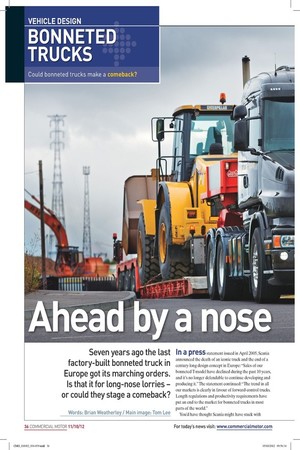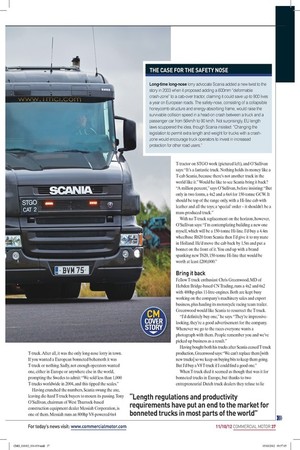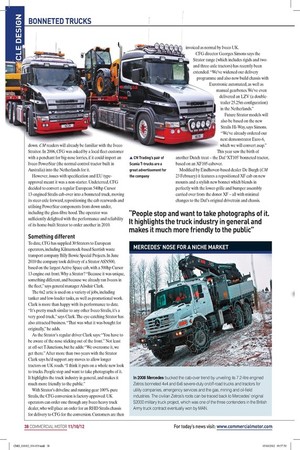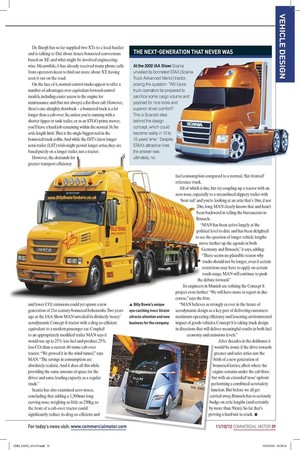Ahead by a nose
Page 29

Page 30

Page 31

Page 32

If you've noticed an error in this article please click here to report it so we can fix it.
In a press statement issued in April 2005, Scania announced the death of an iconic truck and the end of a century-long design concept in Europe: “Sales of our bonneted T-model have declined during the past 10 years, and it’s no longer defendable to continue developing and producing it.” The statement continued: “The trend in all our markets is clearly in favour of forward-control trucks. Length regulations and productivity requirements have put an end to the market for bonneted trucks in most parts of the world.” You’d have thought Scania might have stuck with T-truck. After all, it was the only long-nose lorry in town. If you wanted a European bonneted behemoth it was T-truck or nothing. Sadly, not enough operators wanted one, either in Europe or anywhere else in the world, prompting the Swedes to admit: “We sold less than 1,000 T-trucks worldwide in 2004, and this tipped the scales.” Having crunched the numbers, Scania swung the axe, leaving die-hard T-truck buyers to mourn its passing. Tony O’Sullivan, chairman of West Thurrock-based construction equipment dealer Messiah Corporation, is one of them. Messiah runs an 800hp V8-powered 6x4 T-tractor on STGO work (pictured left), and O’Sullivan says: “It’s a fantastic truck. Nothing holds its money like a T-cab Scania, because there’s not another truck in the world like it.” Would he like to see Scania bring it back? “A million percent,” says O’Sullivan, before insisting: “But only in two forms, a 4x2 and a 6x4 for 150-tonne GCW. It should be top of the range only, with a Hi-line cab with leather and all the toys; a ‘special’ order – it shouldn’t be a mass-produced truck.” With no T-truck replacement on the horizon, however, O’Sullivan says: “I’m contemplating building a new one myself, which will be a 150-tonne Hi-line. I’d buy a 4.4m wheelbase R620 from Scania then I’d give it to my mate in Holland. He’d move the cab back by 1.5m and put a bonnet on the front of it. You end up with a brand spanking new T620, 150-tonne Hi-line that would be worth at least £200,000.”
Bring it back
Fellow T-truck enthusiast Chris Greenwood, MD of Hebden Bridge-based CN Trading, runs a 4x2 and 6x2 with 400hp-plus 11-litre-engines. Both are kept busy working on the company’s machinery sales and export business, plus hauling its motorcycle racing team trailer. Greenwood would like Scania to resurrect the T-truck.
“I’d definitely buy one,” he says. “They’re impressivelooking, they’re a good advertisement for the company. Whenever we go to the races everyone wants a photograph with them. People remember you and we’ve picked up business as a result.” Having bought both his trucks after Scania ceased T-truck production, Greenwood says: “We can’t replace them [with new trucks] so we keep on buying bits to keep them going. But I’d buy a V8 T-truck if I could find a good one.” When T-truck died it seemed as though that was it for bonneted trucks in Europe, but thanks to two entrepreneurial Dutch truck dealers they refuse to lie down. CM readers will already be familiar with the Iveco Straitor. In 2006, CFG was asked by a local fleet customer with a penchant for big-nose lorries, if it could import an Iveco PowerStar (the normal-control tractor built in Australia) into the Netherlands for it.
However, issues with specification and EU typeapproval meant it was a non-starter. Undeterred, CFG decided to convert a regular European 540hp Cursor 13-engined Stralis cab-over into a bonneted truck, moving its steer-axle forward, repositioning the cab rearwards and utilising PowerStar components from down under, including the glass-fibre hood. The operator was sufficiently delighted with the performance and reliability of its home-built Strator to order another in 2010.
Something different
To date, CFG has supplied 30 Strators to European operators, including Kilmarnock-based Scottish waste transport company Billy Bowie Special Projects. In June 2010 the company took delivery of a Strator ASN500, based on the largest Active Space cab, with a 500hp Cursor 13-engine out front. Why a Strator? “Because it was unique, something different, and because we already ran Ivecos in the fleet,” says general manager Alisdair Clark.
The 6x2 artic is used on a variety of jobs, including tanker and low-loader tasks, as well as promotional work. Clark is more than happy with its performance to date. “It’s pretty much similar to any other Iveco Stralis, it’s a very good truck,” says Clark. The eye-catching Strator has also attracted business. “That was what it was bought for originally,” he adds.
As the Strator’s regular driver Clark says: “You have to be aware of the nose sticking out of the front.” Not least at off-set T-Junctions, but he adds: “We overcome it, we get there.” After more than two years with the Strator Clark says he’d support any moves to allow longer tractors on UK roads. “I think it puts on a whole new look to trucks. People stop and want to take photographs of it. It highlights the truck industry in general, and makes it much more friendly to the public.” With Strator’s driveline and running-gear 100% pure Stralis, the CFG conversion is factory-approved. UK operators can order one through any Iveco heavy truck dealer, who will place an order for an RHD Stralis chassis for delivery to CFG for the conversion. Customers are then invoiced as normal by Iveco UK.
CFG director Georges Simons says the Strator range (which includes rigids and twoand three-axle tractors) has recently been extended. “We’ve widened our delivery programme and also now build chassis with Eurotronic automated, as well as manual gearboxes. We’ve even delivered an LZV (a doubletrailer 25.25m configuration) in the Netherlands.” Future Strator models will also be based on the new Stralis Hi-Way, says Simons. “We’ve already ordered our next demonstrator Euro-6, which we will convert asap.” This year saw the birth of another Dutch treat – the Daf ‘XT105’ bonneted tractor, based on an XF105 cabover.
Modified by Eindhoven-based dealer De Burgh (CM 23 February) it features a repositioned XF cab on new mounts and a stylish new bonnet which blends in perfectly with the lower-grille and bumper assembly carried over from the donor XF – all with minimal changes to the Daf’s original drivetrain and chassis. De Burgh has so far supplied two XTs to a local haulier and is talking to Daf about future bonneted conversions based on XF, and what might be involved engineeringwise. Meanwhile, it has already received many phone calls from operators keen to find out more about XT, having seen it out on the road.
On the face of it, normal-control trucks appear to offer a number of advantages over equivalent forward-control models, including easier access to the engine for maintenance and (but not always) a flat-floor cab. However, there’s one almighty drawback – a bonneted truck is a lot longer than a cab-over. So, unless you’re running with a shorter tipper or tank trailer, or as an STGO prime mover, you’ll have a hard job remaining within the normal 16.5m artic length limit. That is the single biggest nail in the bonneted truck coffin. And while the DfT’s latest longer semi-trailer (LST) trials might permit longer artics, they are based purely on a longer trailer, not a tractor.
However, the demands for greater transport efficiency and lower CO2 emissions could yet spawn a new generation of 21st century bonneted behemoths. Two years ago at the IAA Show MAN unveiled its distinctly ‘nosey’ aerodynamic Concept-S tractor with a drag co-efficient equivalent to a modern passenger car. Coupled to an appropriately modified trailer MAN says it would use up to 25% less fuel and produce 25% less CO2 than a current 40-tonne cab-over tractor. “We proved it in the wind tunnel,” says MAN. “The savings in consumption are absolutely realistic. And it does all this while providing the same amount of space for the driver and same loading capacity as a regular truck.” Scania has also examined aero-noses, concluding that adding a 1,500mm long curving nose, weighing as little as 250kg, to the front of a cab-over tractor could significantly reduce its drag co-efficient and fuel consumption compared to a normal, ‘flat-fronted’ reference truck.
All of which is fine, but try coupling-up a tractor with an aero-nose, especially to a streamlined slippery trailer with ‘boat-tail’ and you’re looking at an artic that’s 18m, if not 20m, long. MAN clearly knows that and hasn’t been backward in telling the bureaucrats in Brussels.
“MAN has been active largely at the political level to date and has been delighted to see the question of longer vehicle lengths move further up the agenda in both Germany and Brussels,” it says, adding: “There seems no plausible reason why trucks should not be longer, even if certain restrictions may have to apply on certain roads usage. MAN will continue to push the debate forward.” Its engineers in Munich are refining the Concept S project even further. “We will have more to report in due course,” says the firm.
“MAN believes as strongly as ever in the future of aerodynamic design as a key part of delivering customers maximum operating efficiency and lessening environmental impact of goods vehicles. Concept S is taking truck design in directions that will deliver meaningful results in both fuel economy and emissions levels.” After decades in the doldrums it would be ironic if the drive towards greener and safer artics saw the birth of a new generation of bonneted lorries, albeit where the engine remains under the cab floor, but with an extended ‘nose’ upfront performing a combined aero/safety function. But before we all get carried away, Brussels has to seriously budge on artic lengths (and certainly by more than 50cm). So far that’s proving a hard nut to crack. n











































